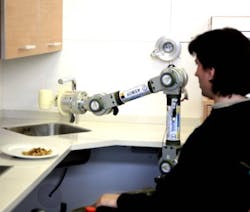Madrid develops robotics for citizen services
A program in Madrid, Spain, is being developed to deployrobots in community service applications that will enhance the quality of life for citizens in metropolitan areas. Promoted by the Autonomous Community of Madrid through the Directorate General of Universities and Research, the Robocity2030 program gathers more than 60 PhDs and 100 researchers, under the guidance of the Robotics Lab at Universidad Carlos III de Madrid (UC3M) and its director, Carlos Balaguer.
The applications for theservice robots within the framework of the Robocity2030 program are divided into two groups: quality of life in open environments -- such as applications in urban infrastructure, detection/deactivation of explosives, maintenance of green spaces -- and quality of life in closed environments -- such as in assistance with play, education, help, rehabilitation, and personalized remote service robot companions.
In the intelligent domestic area, a kitchen is simulated where an assistantrobot such as Asibot performs (shown below). The goal of this type of robot is to allow the disabled, elderly, or individuals with cognitive problems, for example, to live on their own without outside help, so as to improve the quality of their lives, Balaguer explains.
The climber robot can move on vertical surfaces through a docking station system placed on the walls and adjusted to the dimensions of the room where the devices are installed. The movement between them and the tasks carried out are done through previous programming, but the researchers are working on providing the robot with an intelligent system to recognize images in order to carry out tasks autonomously.
Asibot is portable, since it weighs around 10 kg, although the next prototype, which is in its development stage, is said to improve upon current features.
"Assistential robotics,” Balaguer comments, “is a multidisciplinary area which requires the additional incorporation of doctors, therapists, psychologists, and sociologists. In addition, from a technological point of view, the challenge is to make the systems much more user-friendly, much sturdier, and obviously, much more affordable,” he concludes.
SOURCE:UC3M
-- Posted by Carrie Meadows,Vision Systems Design


